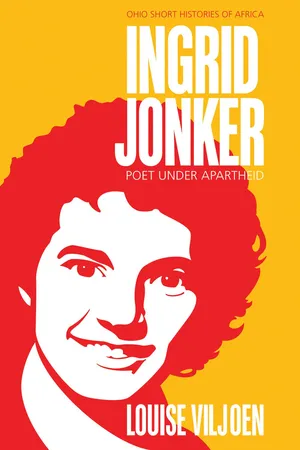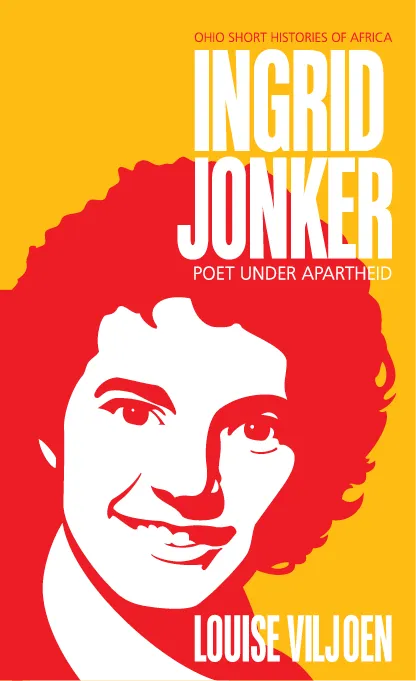Ingrid Jonker
Louise Viljoen
Ohio University Press Athens
Contents
Acknowledgements
Writing Ingrid Jonker
Childhood and youth, 1933–1951
Early adulthood, marriage and motherhood, 1952–1958
Separation, divorce and a new relationship, 1959–1962
Prize-winning poet, 1963–1964
Last days, 1965
Afterlife
Acknowledgements
I gratefully acknowledge the help of the following people in writing this book:
Petrovna Metelerkamp for giving freely of information and advice;
Ann Torlesse and Cecilia Blight for their help in accessing material about Ingrid Jonker at NELM;
NELM for permission to reproduce photographs and literary materials held by them in the Cope Collection;
Lynne Fourie and Marina Brink for their help in accessing material about Ingrid Jonker in the Stellenbosch University Library;
Michael Cope for giving permission to quote from his father’s papers;
The Ingrid Jonker Trust for permission to quote from Ingrid Jonker’s poems and for the use of photographs;
André Brink and Antjie Krog for kind permission to use their translations of some of Ingrid Jonker’s poems from their collection entitled Black Butterflies (Cape Town, 2007);
Breyten Breytenbach for permission to quote from his poem ‘Ballade van ontroue bemindes’;
André Brink for talking to me about Ingrid Jonker;
Gerhard Geldenhuys for information about documents regarding Abraham and Ingrid Jonker in the Western Cape Archives and Office of the Master of the Supreme Court, Cape Town;
Joan-Mari Barendse for invaluable research assistance;
Chris van der Merwe for comments on and advice about the text;
Russell Martin for the careful editing of the text.
Every effort has been made to identify the copyright holders of the photographs reproduced in this book. Should there be any errors or omissions, we shall gladly rectify them in the next impression.
Louise Viljoen
2012
1
Writing Ingrid Jonker
‘There can never be a definitive biography, merely a version, an attempt, an essay which in time reveals how completely all such attempts bear the impress of the age in which it was written.’
– Eric Homberger & John Charmley, The troubled face of biography
The fascination with Ingrid Jonker
When Ingrid Jonker took her own life by walking into the sea at Three Anchor Bay in Cape Town on 19 July 1965 at the age of 31, she became the stuff of legend and rumour. Looking back on her legacy, one may wonder why this is so. The shortness of her life and the slenderness of her literary oeuvre seem out of all proportion to the biographical, critical and creative attention that has been devoted to her. Her collected writings can be contained within one compact volume. Apart from two volumes of poetry published in her lifetime and a volume published posthumously, she left only a few short stories, a play and a scattering of other texts.
To what should one ascribe her iconic status and the continuing fascination with her life and work? The answer to this probably lies in a combination of factors. There is no doubt that the easily sensationalised details of her life provide a provocative glimpse into a particularly turbulent period of Afrikaner and South African history. Her private history (a materially deprived childhood, a difficult relationship with her father, her frank and spontaneous sexuality, her unhappy love affairs, her suicide) coincided with major developments in public history. The 1950s saw a rapid escalation of apartheid laws to ensure the segregation of South African society and the early 1960s began dramatically with the shootings at Sharpeville, the banning of the ANC and PAC, South Africa’s withdrawal from the Commonwealth and the declaration of a Republic. Ingrid’s response to these and other events and her identification with the plight of the oppressed in South Africa brought her into conflict with her father, at that time a National Party politician, as well as with other authority figures of Afrikanerdom. As part of a bohemian circle of friends with liberal values in Cape Town, she identified herself with the ideal of a society in which freedom of speech and association was recognised. Her life was also closely intertwined with the work of the Sestigers, who were busy rewriting Afrikaner history and literature by opposing the political and literary establishment of the time.
Although hers was an eventful life that provides a window on the tensions of South Africa at a certain moment in its history, it would not have made the same impact but for her poetry. For her mentor, Uys Krige, her poetry was ‘the essential Ingrid stripped of her incompleteness, of the little human flaws and shortcomings we all share’.An academic analysis of her poetry’s appeal would refer to its pure lyricism, its powerful almost surrealist imagery, its confident musicality, its sensitivity to all the nuances of her mother tongue and its ability to infuse the political with the personal. It is more difficult to discern why her best poems appeal to both poetry-lovers and poetry-avoiders alike. One of the answers may lie in the fact that she started writing poems when she was about six and her poetry, despite its increasing sophistication, never lost its almost childlike clarity and freshness. It may also be that readers feel the force of her urgency to communicate with others through her poetry, that they feel directly spoken to by her poems.
It is therefore not surprising that it was her poetry, more specifically the poem ‘Die kind’ (translated into English as ‘The child’), that brought her to the attention of South Africa and the larger world when Nelson Mandela read it at the opening of South Africa’s first democratic parliament on 24 May 1994. Without doubt, Mandela’s reference to Ingrid Jonker contributed hugely to the revival of interest in her person and her work. Although she always had a strong following in Afrikaans literary circles,journalists started digging up the details of her life in the week after Mandela’s speech and a new revised edition of her collected works was published before the year was out. In the years that followed new English translations of her work appeared and several documentary films were produced. The first biographical works about her life also started to see the light. A short and gripping biography by the Dutch novelist Henk van Woerden was included in Ik herhaal je (2000), a volume that included Gerrit Komrij’s translations of Jonker’s poetry into Dutch. The first attempt at a comprehensive overview of her life was Petrovna Metelerkamp’s Ingrid Jonker: Beeld van ’n digterslewe (2003). Rather than a conventional biography, this impressive book consisted of a collection of documents about Ingrid Jonker’s life, with the hand of the biographer only visible in the selection and ordering of the material as well as in short interlinking pieces. More information about Ingrid Jonker’s life came to light in 2006 when the clinical psychologist L.M. van der Merwe published a series of interviews conducted with people who were close to her for his doctoral thesis in psychology twelve years after her death, in Gesprekke oor Ingrid Jonker [Conversations about Ingrid Jonker]. In addition to two Afrikaans plays about her life – Ingrid Jonker: Opdrag (created by Jana Cilliers in cooperation with the writer Ryk Hattingh in 1997) and Altyd Jonker (written and produced by Saartjie Botha in 2006) – her life was captured in the 2011 film Black Butterflies by the Dutch director Paula van der Oest, starring Carice van Houten as Ingrid Jonker.
Such is the fascination with Ingrid Jonker that André Brink has spoken of an ‘industry’ that has sprung up around her death.It is a fascination that shows no sign of abating.
Writing Ingrid Jonker
In using the materials available to reconstruct Ingrid Jonker’s life and interpret her work, we must remember that no document is inert or innocent. Letters, diaries, and biographical and autobiographical writings are never neutral representations of reality. They often constitute deliberate acts of self-creation, self-justification or even self-promotion that have to be reckoned with. Moreover, private documents often make use of rhetorical strategies or coded languages that are difficult to interpret. For the biographer, therefore, the task at hand is not simply a matter of decoding the available documents, but rather of cautiously interpreting them. The same goes for information gleaned from interviews conducted with people who knew Ingrid Jonker. Their memories are necessarily determined by the nature of their relationship with her and by their subjective interpretation of events. We also know that memories of the past are subject to complex processes of editing and erasure; nor are they free of self-interest and self-preservation. One could argue that the many photographs of Ingrid Jonker speak unambiguously to the viewer, that they are impervious to the passage of time and the erosion of memory...

